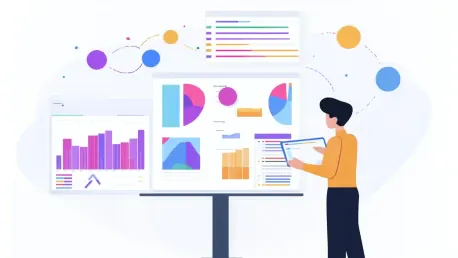Data science and dataops have a critical role to play in developing revenue forecasts that business leaders can count on. The significant challenge in accurately forecasting revenue stems from multiple factors, such as discrepancies in data, the complexity of integrating diverse data sources, and the rapidly changing business environment. This scenario necessitates a sophisticated approach where modern technology amalgamates with traditional financial analysis methods. In this context, integrating data science and dataops offers a structured pathway to enhance revenue forecasting practices, ensuring informed strategic decision-making.
Businesses across various sectors are increasingly looking to harness the power of data analytics, artificial intelligence (AI), and strategic data governance to refine their revenue forecasting models. This involves leveraging data from internal systems like ERPs, CRMs, and marketing automation platforms, coupled with insights from external sources, such as economic indicators, changes in regulation, and even climate forecasts. Accurate revenue forecasting necessitates a meticulous merger of multiple data streams and the deployment of sophisticated analytical tools. Data scientists and technologists are pivotal in this journey, providing the analytical prowess and technological infrastructure necessary to transform raw data into actionable forecasts.
1. Collect Data
Collecting data from diverse and relevant sources is the cornerstone of accurate revenue forecasting. Organizations need to gather information from various internal systems, including Enterprise Resource Planning (ERP) systems, Customer Relationship Management (CRM) platforms, marketing automation tools, and customer service applications. Additionally, it is crucial to incorporate data from external sources such as economic indicators, customer demand trends, regulatory changes, climate forecasts, and political factors. The integration of these diverse data streams provides a holistic view of the business environment, enabling more accurate and comprehensive revenue forecasts.
For instance, ERP systems offer valuable insights into financial transactions, resource management, and operational efficiencies, while CRM platforms provide detailed information on customer interactions, sales funnels, and account management. Meanwhile, marketing automation tools track the performance of advertising campaigns, lead generation efforts, and customer engagement initiatives. Customer service tools further supplement this data by offering feedback on customer satisfaction, repeat purchase likelihood, and service quality. External data sources, providing broader economic trends, consumer behavior patterns, regulatory shifts, and even environmental forecasts, enrich these insights, painting a full picture of the factors influencing revenue growth.
2. Select Time Frames
Selecting appropriate time frames for analysis is pivotal in ensuring accurate and actionable revenue forecasts. This step involves choosing specific periods for data analysis to determine which data sets and segments are necessary. The choice of time frames depends on the nature of the business, the duration of its sales cycles, seasonal trends, and the frequency of external factors influencing the market. Analysts must determine whether to focus on short-term, medium-term, or long-term horizons, or perhaps a combination of these, to develop a robust forecasting model.
For example, businesses with seasonal products may require a more granular, month-by-month analysis, while others in sectors like real estate or manufacturing with longer sales cycles might benefit from quarterly or annual projections. Short-term forecasts are typically used for immediate operational decisions, while medium-term forecasts aid in tactical planning and resource allocation. Long-term forecasts provide strategic insights that support major business decisions and long-range planning. Selecting the correct time frames ensures that the forecasts are relevant and align with the organization’s operational and strategic objectives.
3. Review External Factors
Economic indicators, customer demand trends, regulatory changes, climate forecasts, and political factors can significantly impact revenue projections. Reviewing these external influences, constraints, and other risks that might accelerate or inhibit growth is an essential step in the forecasting process. This includes examining the business’s supply chain factors, strategic decisions, labor conditions, and other global and local events. Understanding these elements helps organizations prepare for potential disruptions and identify opportunities that may arise from changes in the external environment.
For instance, fluctuations in economic conditions can directly influence consumer spending habits, impacting sales revenue. Regulatory changes might introduce new compliance costs or open up new markets, depending on the nature of the changes. Climate forecasts can affect industries like agriculture, retail, and travel, which are susceptible to weather patterns. Political factors, such as trade policies, tariffs, and international relations, can alter supply chains and market access. By thoroughly examining these external factors, businesses can build more resilient and adaptive revenue forecasting models, better equipped to navigate uncertainties and capitalize on emerging trends.
4. Choose Tools and Models
Choosing the right tools and forecasting models is crucial for predicting revenue accurately from both existing customers and new customer orders. This step involves selecting appropriate tools and models that can handle the complexity and volume of data generated by modern businesses. Organizations often use a combination of top-down and bottom-up approaches to create multiple models that consider various planning scenarios, benchmarking them against external forecasts for validation.
Top-down modeling focuses on estimating revenue based on broad economic and market trends, while bottom-up modeling involves a detailed analysis of individual sales pipelines and customer behavior. This dual approach ensures a comprehensive view of potential revenue streams. Companies may use advanced analytics tools, machine learning algorithms, and specialized forecasting software to enhance the accuracy of these models. Tools like SAP Revenue Growth Optimization, Workday Adaptive Planning, Microsoft Dynamics Sales, and Netsuite provide robust frameworks for integrating data sources and generating actionable insights. These platforms often include collaboration features, annotation capabilities, and advisory functions that support the FP&A workflow, improving the overall accuracy and reliability of the forecasts.
5. Present and Integrate Models
Once the forecasting models are finalized, presenting them to executives and integrating them into existing ERP, CRM, and other planning tools is the next step. This ensures that the forecasts are aligned with the organization’s resources and strategic objectives. The models should be easy to understand and actionable, providing clear insights that executives can use to make informed decisions. Integration into planning tools allows for real-time monitoring and adjustments, ensuring that the forecasts remain relevant and accurate over time.
Executives need to know not just the forecasted numbers but also the assumptions, methodologies, and potential risks associated with the forecasts. Visualizations, summary reports, and dashboards can help in effectively communicating these aspects. Continuous monitoring of the forecasting models allows for adjustments based on real-time data, ensuring that the forecasts stay aligned with actual business performance. This iterative process improves the accuracy of the predictions and helps in aligning organizational resources effectively, leading to better strategic and tactical decision-making. Regular updates and reviews of the forecasts ensure that they adapt to changing market conditions and provide valuable insights for steering the organization toward its goals.









